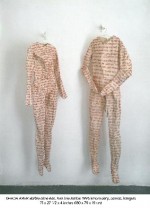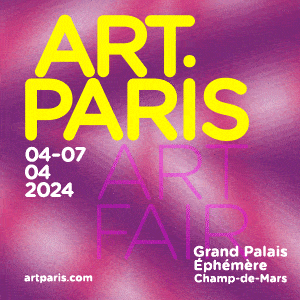Whitehot Magazine
April 2024
"The Best Art In The World"
"The Best Art In The World"
April 2024
September 2008, Ghada Amer, Brooklyn Museum of Art

Ghada Amer (Egypt, b. 1963) Red Diagonales, 2000 Acrylic, embroidery and gel medium on canvas 72 x 72 in. (182.9 x 182.9 cm) Collection of Yoko Ono, New York copyright Ghada Amer. Courtesy Gagosian Gallery.
Ghada Amer, “Love Has No End”
Elizabeth A Sackler Center for Feminist Art
Brooklyn Museum of Art
February 16- October 19, 2008
Written by Anne Schruth
As a roughly chronological exploration of Amer’s ideological progression as a feminist artist, her latest exhibit, “Love Has No End,” curated by Maura Reilly, Ph.D., is a perfect little microcosm of her quite varied career over the past two decades. A multi-media artist born in Egypt, schooled in France, and currently residing in New York City, Amer uses her work to speak unapologetically about the repression of women, with just a dash of anti-war sentiment, and utilizes everything from installation and garden art to plywood and embroidered canvas to make her point.
The ideological potency of this new exhibit lies in Amer’s use of contrast—masculine and feminine, restraint and liberation. I was especially struck by her purposeful use of materials to create this tension and thought this gendered dichotomy most notable in her piece, “Untitled” (1990), which features a dress pattern outlined in thread nailed to a piece of plywood.
The conflict between repression and agency is particularly arresting in a series of embroidered paintings that juxtapose pornographic images of women with illustrations of princesses from children’s Disney movies, such as Belle from Beauty and the Beast, as seen in her piece, “And the beast” (2004). This shocking combination caused a collision in my brain since all at once I was flooded with regressive childhood memories of watching these “innocent” movies while processing these erotic images of women taken from pornographic publications. As I am sure is the point, I was challenged to rethink my ideas about what is feminine and beautiful. Amer, herself, declares that sexuality is innate and by using these once degrading images, she claims them as her own and exposes the naturalness and beauty of female sexuality.
Amer’s ode to the female struggle with culturally imposed norms also extends into the realm of duty, responsibility, and models of behavior, as expressed in her series regarding the plight of “bored women,” (as Amer calls them) condemned to a life of domesticity. In works such as “Cinq femmes au travail (Five women at work)” (1991), and “Le Femme qui repasse (The woman who irons)” (1992), she uses embroidery and acrylic on canvas, as well as colored pencil on paper, to depict women performing domestic duties. Forever trapped in monotony, these women, who look like they were cut out of an ad for laundry detergent, conjure up thoughts of a prison created by perpetuated socio-cultural beliefs regarding what constitutes an appropriate occupation of a woman’s time.
This concept of restraint is also presented in a not-so-subtle way with her piece, “Barbie Loves Ken, Ken Loves Barbie,” which consists of two life-size His-and-Her’s straightjackets with the title phrase embroidered on every inch of the fabric. Instantly invoking ideas about the binding nature of gender roles, culturally reinforced notions about what a happy relationship looks like, and the myth of domestic bliss, this somewhat jolting piece leaves little room for reinterpretation of the artist’s intended subtext.
I was perhaps most impressed with the way Amer’s use of conflict and contrast is rounded out by the layout of the gallery space itself. In this two-room exhibit, the left-hand and back walls of the first room are filled with works concerning the suppression of women by the weight of traditional models for feminine behavior. Once you step through the doorway into the second room, however, the images on this same wall become stark expressions of unabashed female sexuality and empowerment— unhindered by expectation.
This collection also includes a series of photographs showcasing Amer’s more globally-minded garden, installation and performative art from around the world (a weak point for the most part, I felt, since much was lost in the translation through the lens) as well as a display of her piece “The Reign of Terror.” This inciting installation disguised as a seemingly homey dining room scene is composed of two adjacent walls covered in wallpaper with many derivations of the word “terrorism” defined over and over again in teeny-tiny print. And resting just a few feet in front of these walls is a table with place settings featuring the phrase, “Terrorism is not indexed in Arabic dictionaries.”
Ultimately, it is stimulating, thought-provoking and often sharply contradictory subject matter such as this combined with stunning aesthetics, most notably with her use of inflammatory color in pieces like “Red Diagonales,” which makes Amer’s work deeply effecting and this new exhibit well worth a visit.

Anne Schruth
Anne Schruth is a graduate of New York University and currently works as a freelance journalist in New York
anne.schruth@gmail.com











